Rock–Oil–Brine Dominant Mechanisms in Smart Water Flooding
Abstract
:1. Introduction
2. Experimental Section
2.1. Brines
2.2. Crude Oil
2.3. Rock Samples
2.3.1. Berea Slices
2.3.2. Berea Samples
2.4. Contact Angle and IFT Measurements
2.5. Coreflooding Tests
2.6. Capillary Electrophoresis (CE)
3. Results and Discussion
3.1. Effect of Droplet Size and Stabilization Time on Contact Angle
3.2. Effect of Brine Concentration on Contact Angle
Effect of Brine Concentration on Interfacial Tension (IFT): Oil–Brine Tests
3.3. Coreflooding Tests
3.4. Ionic Analysis
3.4.1. Coreflooding Displacement in the Absence of Oil–Fluid–Rock Interaction Evaluation
3.4.2. Coreflooding Displacement: Crude Oil–Rock–Brine
- Chloride and sodium dilution effects are observed. However, Cl− concentration in the effluents reached the injected concentration after 1.5 PVi, showing a slight increase during the second half of the flood (up to 53 ppm above the injected concentration). This behavior is similar to the one observed during the experiment without oil (Figure 10).
- Potassium concentration showed a similar trend to that observed during the coreflood test without oil. However, the injected concentration was reached faster (≈3.5 PVi) when the oil phase was included.
- The concentration of cations (Na+, Mg2+, and Ca2+) not included in the injected brine was produced during 6 PVi. Sodium showed its dilution stabilizing (40–60 ppm) until the end of the flood. Mg2+ elution evidenced its dilution and increased up to 58 ppm, decreasing gradually until reaching 18 ppm after the injection of 6 PVs. Nevertheless, calcium concentration showed completely different behavior. Ca2+ initially decreases due to the dilution effects of the FB saturating (Swi) the core plug reaching a minimum of 48 ppm (≈0.75 PVi). At this point, its concentration started increasing and stayed above 126 ppm for 2 PVi, and after 3 PVi, Ca2+ started decreasing but stayed above 45 ppm throughout the displacement test.
- Finally, the effluents of this coreflood showed the presence of low-molecular-weight (MW) organic anions such as formate (99–57 ppm) and acetate (63–43 ppm) at the early stages of production (0.5 PVi). However, these organic anions were not identified beyond this point.
- The rapid salinity reduction was evidenced during the CaCl2 (DE4) injection, especially for chloride and sodium, given the major differences between the FB and the injected brine.
- A sharp chloride dilution effect (difference of 4919 ppm) was observed. The Cl− in the effluents reached the injected concentration after 1.5 PVi, staying close but always above (maximum of 344 ppm) the injected concentration of 1309 ppm throughout the displacement test. This behavior was also observed in the single-phase coreflood for at least 10 PVi until a decrease in Cl- concentration was recorded (Figure 10).
- Calcium concentration injected in the CaCl2 brine was 219 ppm higher than that included in the field brine (FB). Therefore, the dilution effect observed between 0.5 and 1.5 PVi is attributed to the displacement of the FB by CaCl2. After the 1.5 PVi, Ca2+ remained remarkably stable and close to the injected concentration (722 ppm). This suggests that the calcium in the crude oil (Table 2), exchanged with other low-salinity brines (Figure 14 and Figure 15), is somehow equilibrated with the Ca2+ in the injected brine, diminishing its exchange capacity.
- Sodium was not present in the CaCl2 brine injected, but it helps demonstrate this cation’s dilution effect during the coreflood test. Na+ reached a minimum concentration of 61 ppm at 2.5 PVi. Beyond this point, sodium was detected in some samples with concentrations ranging from 3 to 55 ppm. Other cations (K+ and Mg2+) not included in the injected brine showed a similar trend. Mg2+ also showed a dilution effect, and its concentration remained stable and higher (26 to 260 ppm) than the injected concentration (40 ppm) for 2.75 PVi. Still, it was not further detected during the second half of the flood. Potassium was only detected after 1 PVi for 1 pore volume (60 to 100 ppm).
- Effluents of this experiment also showed the presence of low-MW organic anions such as formate (180–7 ppm) and acetate (93–21 ppm) before the first PVi. It is worth mentioning that these carboxylate concentration were higher than those identified during DE3 injecting KCl (Figure 15).
3.4.3. Coreflooding Displacement Comparison
- Cl− concentration [Cl−] eluted during the displacement efficiency (with oil) is higher than the single-phase experiment.
- [Cl−] is very similar in both types of corefloods (no major effect is evidenced due to the presence of oil).
4. Conclusions
Author Contributions
Funding
Data Availability Statement
Acknowledgments
Conflicts of Interest
References
- Short-Term Energy Outlook (STEO). U.S. Energy Information Administration. 2023. Available online: https://www.eia.gov/outlooks/steo/pdf/steo_full.pdf (accessed on 15 February 2023).
- Aghaeifar, Z.; Strand, S.; Puntervold, T.; Austad, T.; Sajjad, F.M. Smart Water injection strategies for optimized EOR in a high temperature offshore oil reservoir. J. Pet. Sci. Eng. 2018, 165, 743–751. [Google Scholar] [CrossRef]
- Qiao, C.; Li, L.; Johns, R.T.; Xu, J. A Mechanistic Model for Wettability Alteration by Chemically Tuned Waterflooding in Carbonate Reservoirs. SPE J. 2015, 20, 767–783. [Google Scholar] [CrossRef] [Green Version]
- Alvarado, V.; Manrique, E. Enhanced oil recovery: An update review. Energies 2010, 3, 1529–1575. [Google Scholar] [CrossRef]
- Hassan, A.M.; Ayoub, M.; Eissa, M.; Al-Shalabi, E.W.; Al-Mansour, A.; Al-Quraishi, A. Increasing Reservoir Recovery Efficiency through Laboratory-Proven Hybrid Smart Water-Assisted Foam (SWAF) Flooding in Carbonate Reservoirs. Energies 2022, 15, 3058. [Google Scholar] [CrossRef]
- Sarmah, S.; Gogoi, S.B.; Jagatheesan, K.; Hazarika, K. Formulation of a combined low saline water and polymer flooding for enhanced oil recovery. Int. J. Ambient. Energy 2019, 43, 1089–1097. [Google Scholar] [CrossRef]
- Maya, G.; Cardona, L.; Rueda, M.; Cortés, F. Effect of ionic strength in low salinity water injection processes. CTyF-Cienc. Tecnol. Futur. 2020, 10, 17–26. [Google Scholar] [CrossRef]
- Maya, G.; Herrera, J.J.; Orrego, J.A.; Rojas, F.A.; Rueda, M.F.; Eduardo, J. Efecto de la composición iónica en interacciones crudo salmuera en la inyección de agua de composición química controlada resultados preliminares. Revista Fuentes el Reventón Energético 2018, 16, 73–82. [Google Scholar]
- Liu, F.; Wang, M. Review of low salinity waterflooding mechanisms: Wettability alteration and its impact on oil recovery. Fuel 2020, 267, 117112. [Google Scholar] [CrossRef]
- Ai-Saedi, H.N.; Flori, R.E. Enhanced oil recovery of low salinity water flooding in sandstone and the role of clay. Pet. Explor. Dev. 2018, 45, 927–931. [Google Scholar] [CrossRef]
- Al-Shalabi, E.W.; Sepehrnoori, K.; Pope, G. An improved method for estimating volumetric sweep efficiency of low salinity water injection. SPE-172279-MS. In Proceedings of the SPE Annual Caspian Technical Conference and Exhibition, Astana, Kazakhstan, 12–14 November 2014. [Google Scholar]
- Shaker Shiran, B.; Skauge, A. Enhanced oil recovery (EOR) by combined low salinity water/polymer flooding. Energy Fuels 2013, 27, 1223–1235. [Google Scholar] [CrossRef]
- Fredriksen, S.B.; Rognmo, A.U.; Fernø, M.A. Pore-scale mechanisms during low salinity waterflooding: Oil mobilization by diffusion and osmosis. J. Pet. Sci. Eng. 2018, 163, 650–660. [Google Scholar] [CrossRef]
- Tang, G.Q.; Morrow, N.R. Salinity, Temperature, Oil Composition, and Oil Recovery by Waterflooding. SPE Reserv. Eng. 1997, 12, 269–276. [Google Scholar] [CrossRef]
- Liu, M.; Xu, S.; Zhu, S.; Wu, J.; Bai, B.; Sun, C. Ion-induced oil–water wettability alteration of rock surfaces. Part II: Base interactions between oil and solid. Chem. Eng. Sci. 2021, 236, 116521. [Google Scholar] [CrossRef]
- Nasralla, R.A.; Mahani, H.; van der Linde, H.A.; Marcelis, F.H.M.; Masalmeh, S.K.; Sergienko, E.; Brussee, N.J.; Pieterse, S.G.J.; Basu, S. Low salinity waterflooding for a carbonate reservoir: Experimental evaluation and numerical interpretation. J. Pet. Sci. Eng. 2018, 164, 640–654. [Google Scholar] [CrossRef]
- Piñerez Torrijos, I.D.; Puntervold, T.; Strand, S.; Austad, T.; Bleivik, T.H.; Abdullah, H.I. An experimental study of the low salinity Smart Water—Polymer hybrid EOR effect in sandstone material. J. Pet. Sci. Eng. 2018, 164, 219–229. [Google Scholar] [CrossRef]
- Takeya, M.; Shimokawara, M.; Elakneswaran, Y.; Nawa, T.; Takahashi, S. Predicting the electrokinetic properties of the crude oil/brine interface for enhanced oil recovery in low salinity water flooding. Fuel 2019, 235, 822–831. [Google Scholar] [CrossRef]
- Xie, Q.; Liu, F.; Chen, Y.; Yang, H.; Saeedi, A.; Hossain, M.M. Effect of electrical double layer and ion exchange on low salinity EOR in a pH controlled system. J. Pet. Sci. Eng. 2019, 174, 418–424. [Google Scholar] [CrossRef]
- Yu, M.; Zeinijahromi, A.; Bedrikovetsky, P.; Genolet, L.; Behr, A.; Kowollik, P.; Hussain, F. Effects of fines migration on oil displacement by low-salinity water. J. Pet. Sci. Eng. 2019, 175, 665–680. [Google Scholar] [CrossRef]
- Han, Y.; Zhou, C.; Yu, J.; Li, C.; Hu, F.; Xu, H.; Yuan, C. Experimental investigation on the effect of wettability on rock-electricity response in sandstone reservoirs. Fuel 2019, 239, 1246–1257. [Google Scholar] [CrossRef]
- Hazarika, K.; Gogoi, S.B. Clay Analysis of Upper Assam Basin for Chemical Enhanced Oil Recovery. J. Geol. Soc. India 2021, 97, 138–144. [Google Scholar] [CrossRef]
- Doust, A.R.; Puntervold, T.; Austad, T. Chemical verification of the EOR mechanism by using low saline/smart water in sandstone. Energy Fuels 2011, 25, 2151–2162. [Google Scholar] [CrossRef]
- Lashkarbolooki, M.; Ayatollahi, S.; Riazi, M. The impacts of aqueous ions on interfacial tension and wettability of an asphaltenic-acidic crude oil reservoir during smart water injection. J. Chem. Eng. Data 2014, 59, 3624–3634. [Google Scholar] [CrossRef]
- Ghorbani, M.; Rashidi, F.; Mousavi-Dehghani, A. Investigation of crude oil properties impact on wettability alteration during low salinity water flooding using an improved geochemical model. Sci. Rep. 2022, 12, 6600. [Google Scholar] [CrossRef]
- Tetteh, J.T.; Brady, P.; Barati Ghahfarokhi, R. Review of low salinity waterflooding in carbonate rocks: Mechanisms, investigation techniques, and future directions. Adv. Colloid Interface Sci. 2020, 284, 102253. [Google Scholar] [CrossRef]
- Strand, S.; Puntervold, T.; Austad, T. Water based EOR from clastic oil reservoirs by wettability alteration: A review of chemical aspects. J. Pet. Sci. Eng. 2016, 146, 1079–1091. [Google Scholar] [CrossRef]
- Rezaeidoust, A.; Puntervold, T.; Strand, S.; Austad, T. Smart water as wettability modifier in carbonate and sandstone: A discussion of similarities/differences in the chemical mechanisms. Energy Fuels 2009, 23, 4479–4485. [Google Scholar] [CrossRef]
- Gbadamosi, A.; Patil, S.; al Shehri, D.; Kamal, M.S.; Hussain SM, S.; Al-Shalabi, E.W.; Hassan, A.M. Recent advances on the application of low salinity waterflooding and chemical enhanced oil recovery. Energy Rep. 2022, 8, 9969–9996. [Google Scholar] [CrossRef]
- Snosy, M.F.; Abu El Ela, M.; El-Banbi, A.; Sayyouh, H. Comprehensive investigation of low-salinity waterflooding in sandstone reservoirs. J. Pet. Explor. Prod. Technol. 2020, 10, 2019–2034. [Google Scholar] [CrossRef] [Green Version]
- Song, J.; Wang, Q.; Shaik, I.; Puerto, M.; Bikkina, P.; Aichele, C.; Biswal, S.L.; Hirasaki, G.J. Effect of salinity, Mg2+ and SO42− on “smart water”-induced carbonate wettability alteration in a model oil system. J. Colloid Interface Sci. 2020, 563, 145–155. [Google Scholar] [CrossRef]
- Gandomkar, A.; Rahimpour, M.R. The impact of monovalent and divalent ions on wettability alteration in oil/low salinity brine/limestone systems. J. Mol. Liq. 2017, 248, 1003–1013. [Google Scholar] [CrossRef]
- Yang, J.; Dong, Z.; Dong, M.; Yang, Z.; Lin, M.; Zhang, J.; Chen, C. Wettability Alteration during Low-Salinity Waterflooding and the Relevance of Divalent Ions in This Process. Energy Fuels 2016, 30, 72–79. [Google Scholar] [CrossRef]
- Al-Saedi, H.N.; Alhuraishawy, A.K.; Flori, R.; Brady, P.V. Sequential injection mode of high-salinity/low-salinity water in sandstone reservoirs: Oil recovery and surface reactivity tests. J. Pet. Explor. Prod. Technol. 2019, 9, 261–270. [Google Scholar] [CrossRef] [Green Version]
- Manrique, E.; Delgadillo, C.; Maya, G.; Gelvis, J. EOR Screening Methods Assisted by Digital Rock Analysis: A Step Forward. In Proceedings of the SPE Latin American and Caribbean Petroleum Engineering Conference, Bogota, Colombia, 27–31 July 2020. [Google Scholar]
- dos Santos, R.G.; Mohamed, R.S.; Bannwart, A.C.; Loh, W. Contact angle measurements and wetting behavior of inner surfaces of pipelines exposed to heavy crude oil and water. J. Pet. Sci. Eng. 2006, 51, 9–16. [Google Scholar] [CrossRef]
- Aslan, S.; Fathi Najafabadi, N.; Firoozabadi, A. Non-monotonicity of the Contact Angle from NaCl and MgCl2 Concentrations in Two Petroleum Fluids on Atomistically Smooth Surfaces. Energy Fuels 2016, 30, 2858–2864. [Google Scholar] [CrossRef]
- Farajzadeh, R.; Guo, H.; van Winden, J.; Bruining, J. Cation Exchange in the Presence of Oil in Porous Media. ACS Earth Space Chem. 2017, 1, 101–112. [Google Scholar] [CrossRef] [Green Version]
- Nasralla, R.A.; Bataweel, M.A.; Nasr-El-Din, H.A. Investigation of wettability alteration and oil-recovery improvement by low-salinity water in sandstone rock. J. Can. Pet. Technol. 2013, 52, 144–154. [Google Scholar] [CrossRef]
- Mehana, M.; Fahes, M.; Kang, Q.; Viswanathan, H. Molecular simulation of double layer expansion mechanism during low-salinity waterflooding. J. Mol. Liq. 2020, 318, 114079. [Google Scholar] [CrossRef]
- Fahim, M.A.; Elkilani, A.; Alsahhaf, T. Fundamentals of Petroleum Refining, 1st ed.; Elsevier: Amsterdam, The Netherlands, 2010. [Google Scholar]
- Joonaki, E.; Hassanpouryouzband, A.; Burgass, R.; Tohidi, B. Effect of Water Chemistry on Asphaltene Stabilised Water in Oil Emulsions—A New Search for Low Salinity Water Injection Mechanism. In Proceedings of the 79th EAGE Conference & Exhibition, Paris, France, 12–15 July 2017. [Google Scholar] [CrossRef]
- Garcia-Olvera, G.; Alvarado, V. The Potential of Sulfate as Optimizer of Crude Oil-Water Interfacial Rheology to Increase Oil Recovery During Smart Water Injection in Carbonates. In Proceedings of the SPE Improved Oil Recovery Conference, Tulsa, OK, USA, 9–12 April 2016. [Google Scholar] [CrossRef]
- Collins, I.R.; Couves, J.W.; Hodges, M.; McBride, E.K.; Pedersen, C.S.; Salino, P.A.; Webb, K.J.; Wicking, C.; Zeng, H. Effect of Low Salinity Waterflooding on the Chemistry of the Produced Crude Oil. In Proceedings of the SPE Improved Oil Recovery Conference, Tulsa, OK, USA, 14–18 April 2018. [Google Scholar]
- Mahzari, P.; Sohrabi, M. Impact of Micro-Dispersion Formation on Effectiveness of Low Salinity Waterflooding. In Proceedings of the IOR 2015—18th European Symposium on Improved Oil Recovery, Dresden, Germany, 14–16 April 2015. [Google Scholar] [CrossRef]

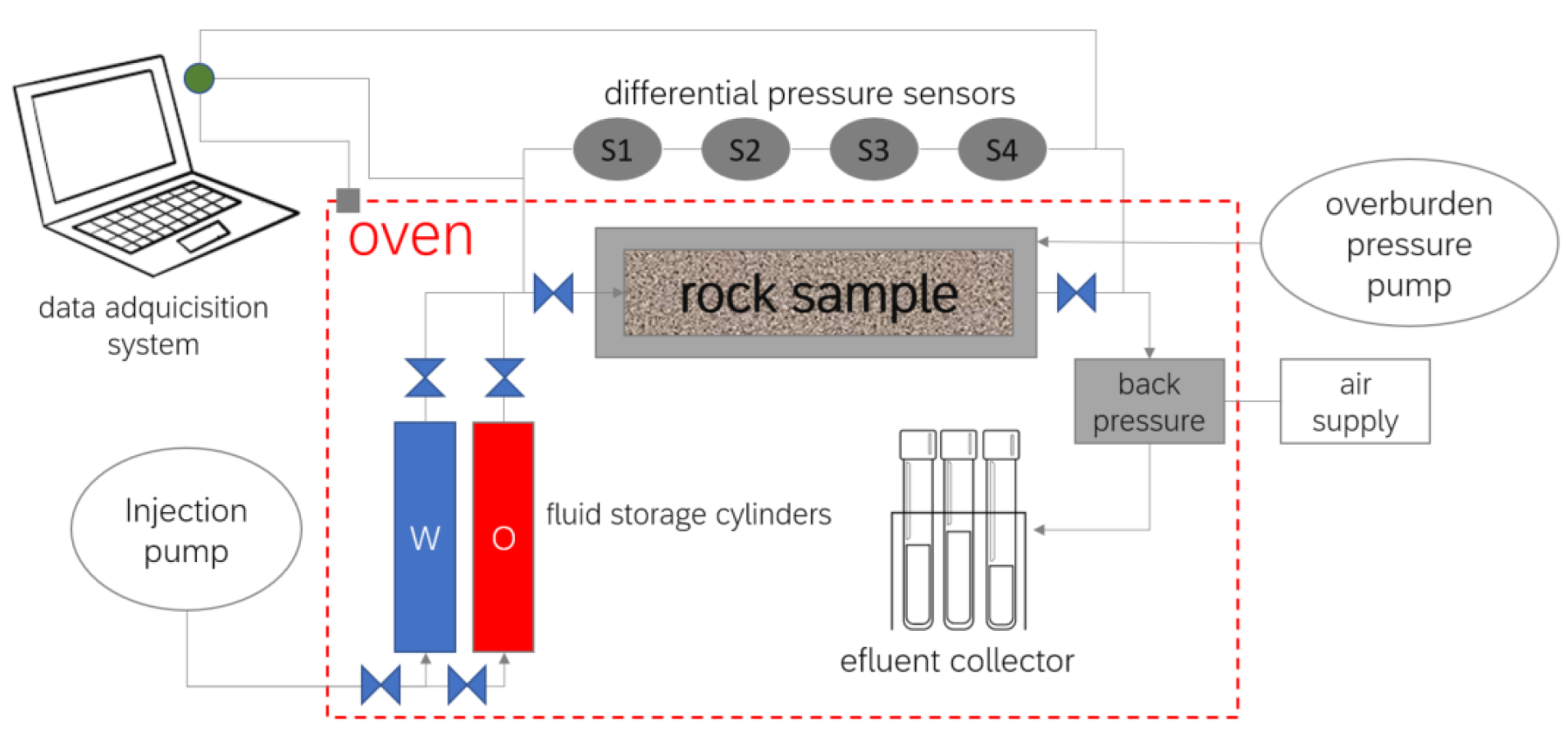
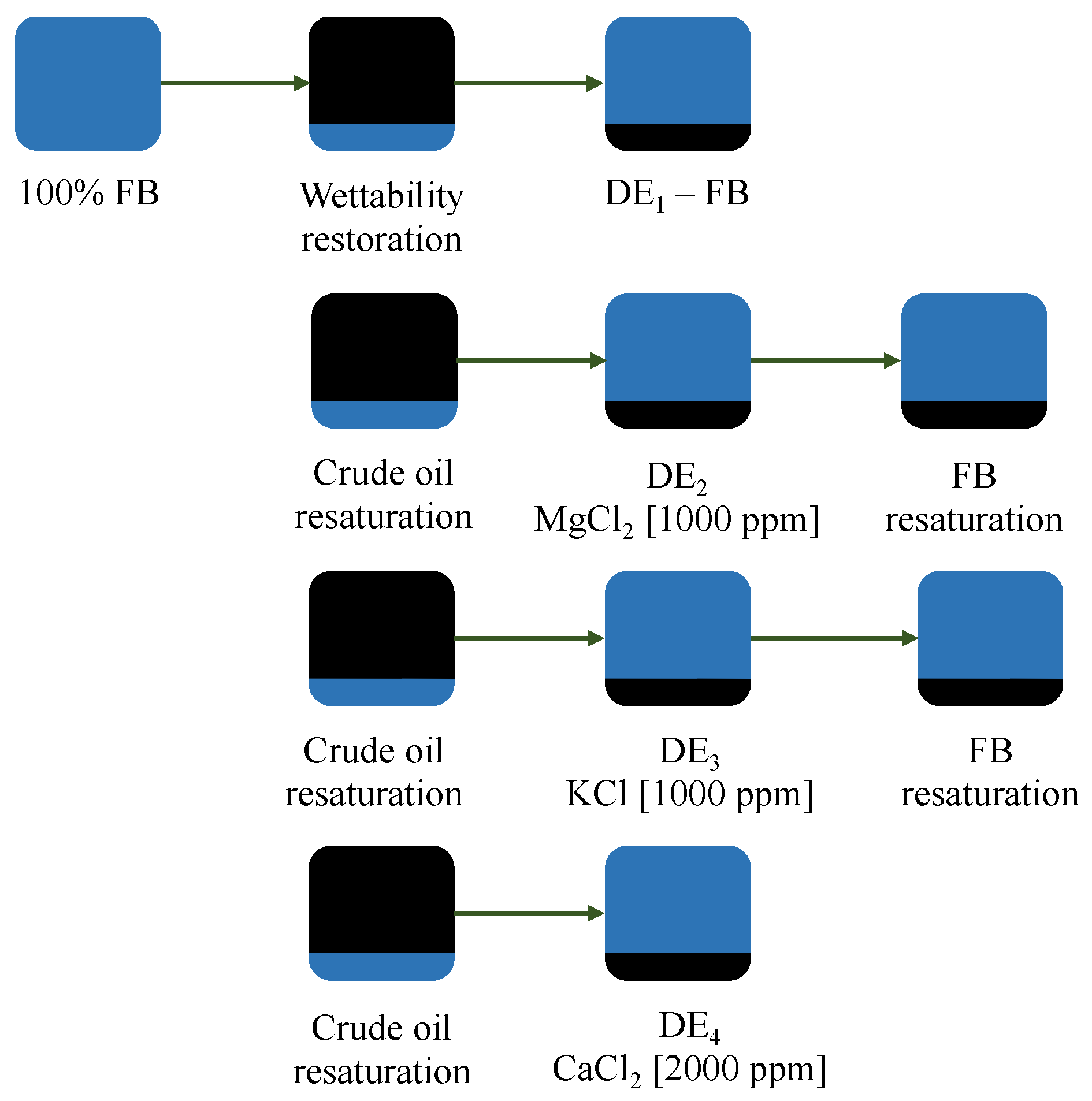

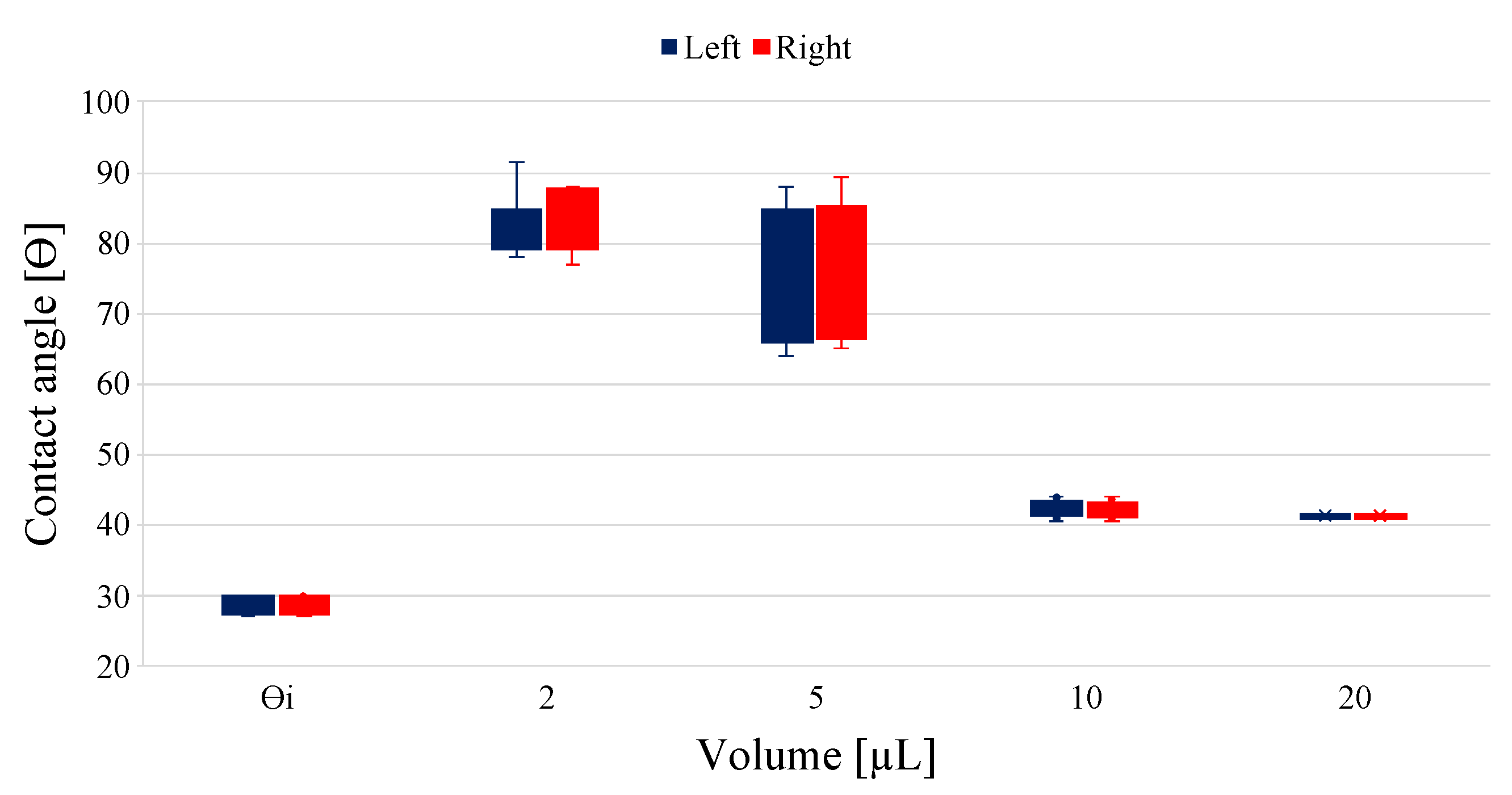


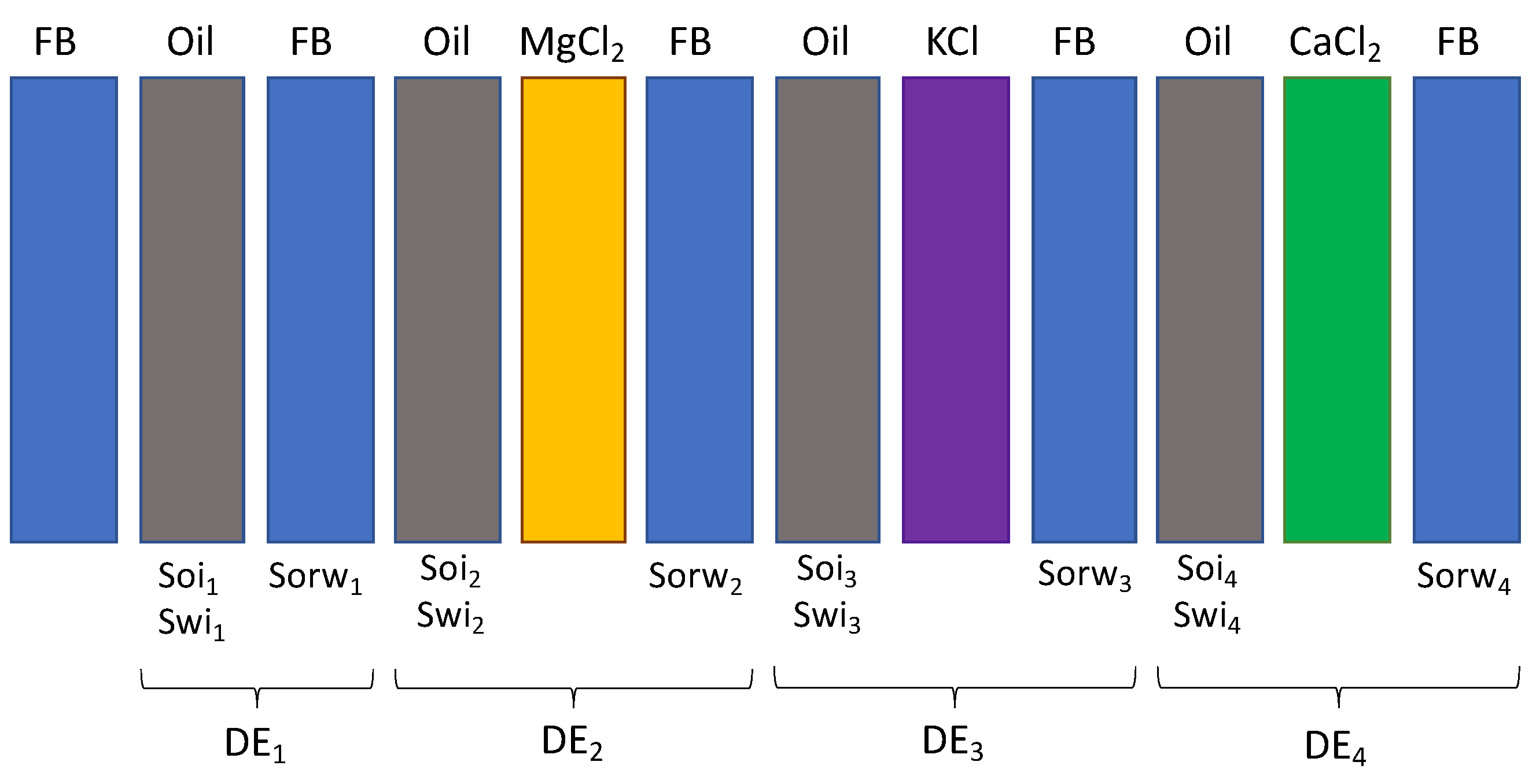

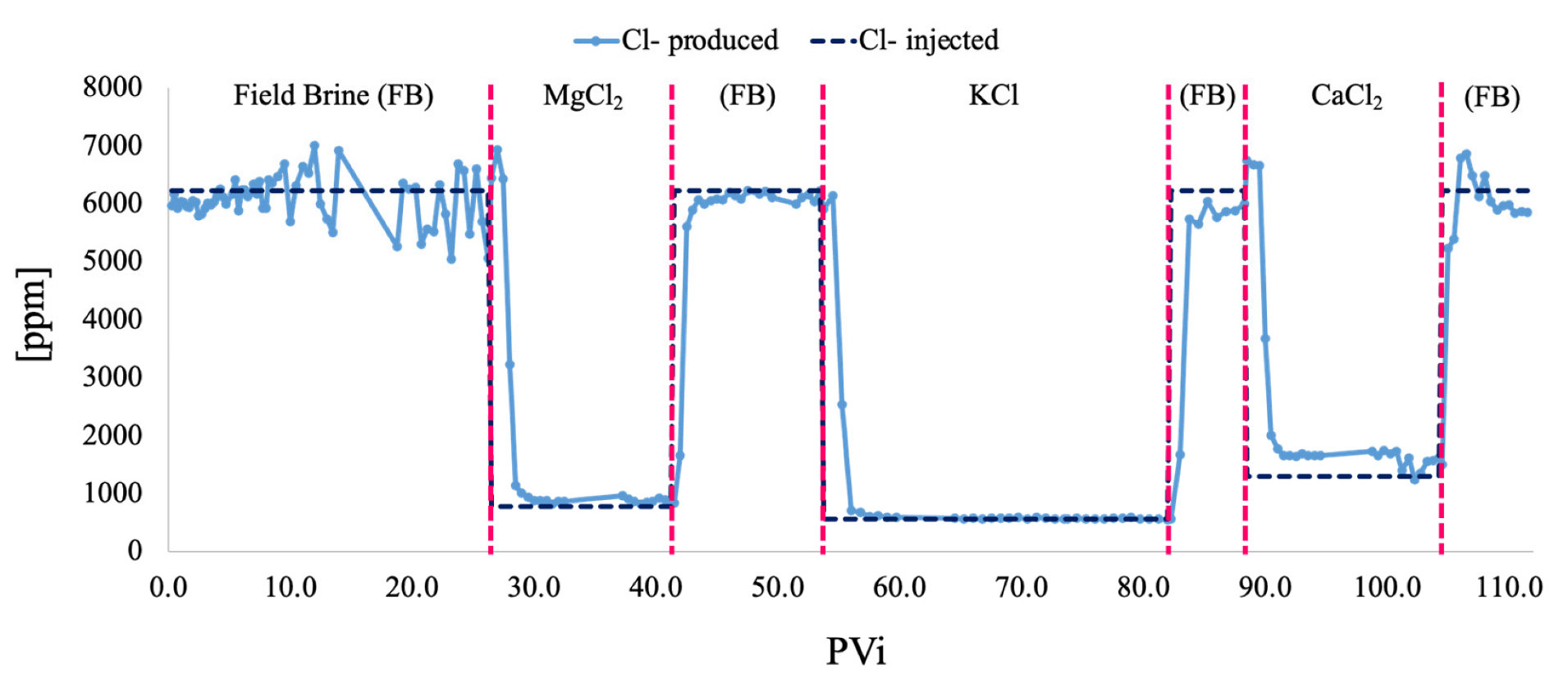



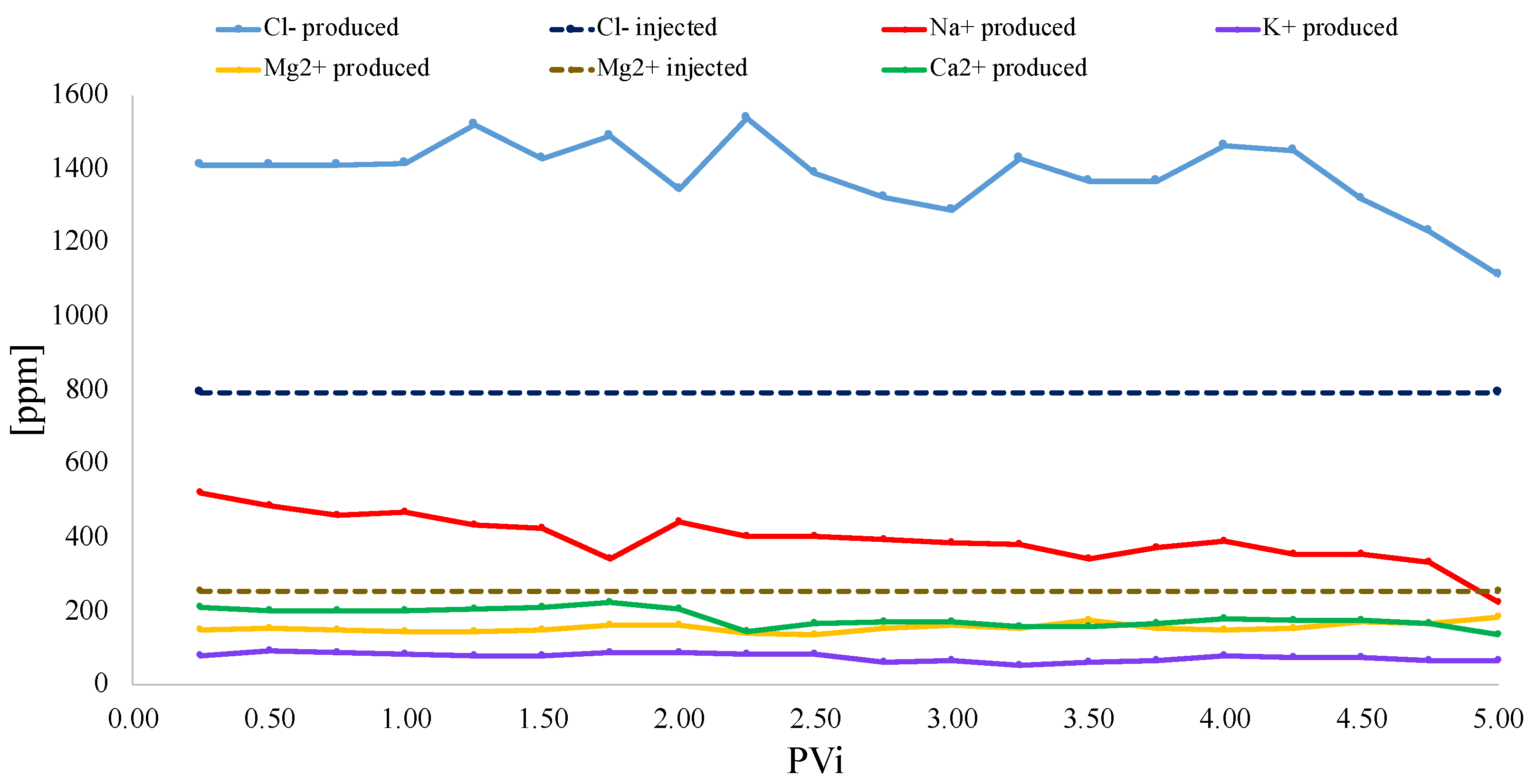

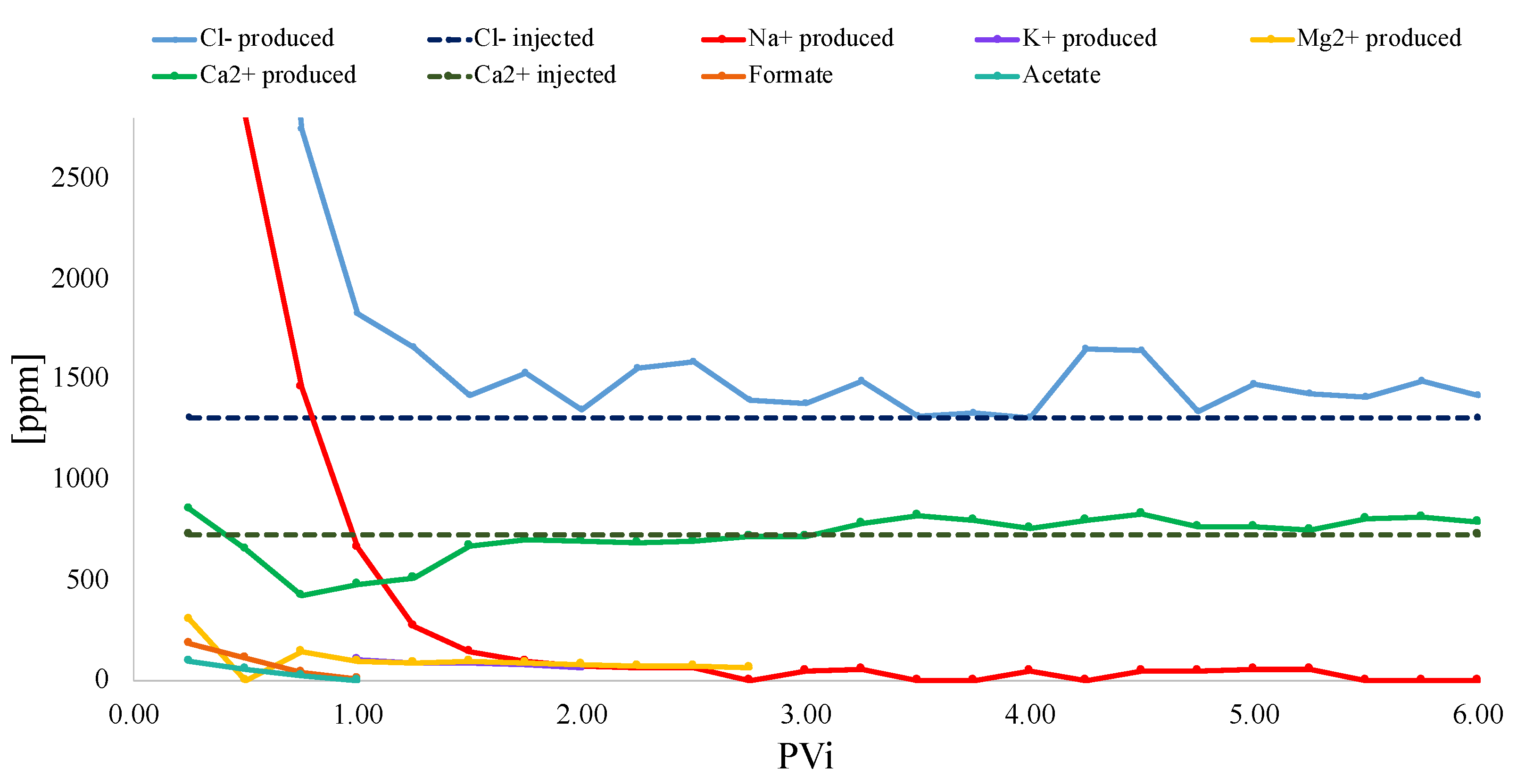

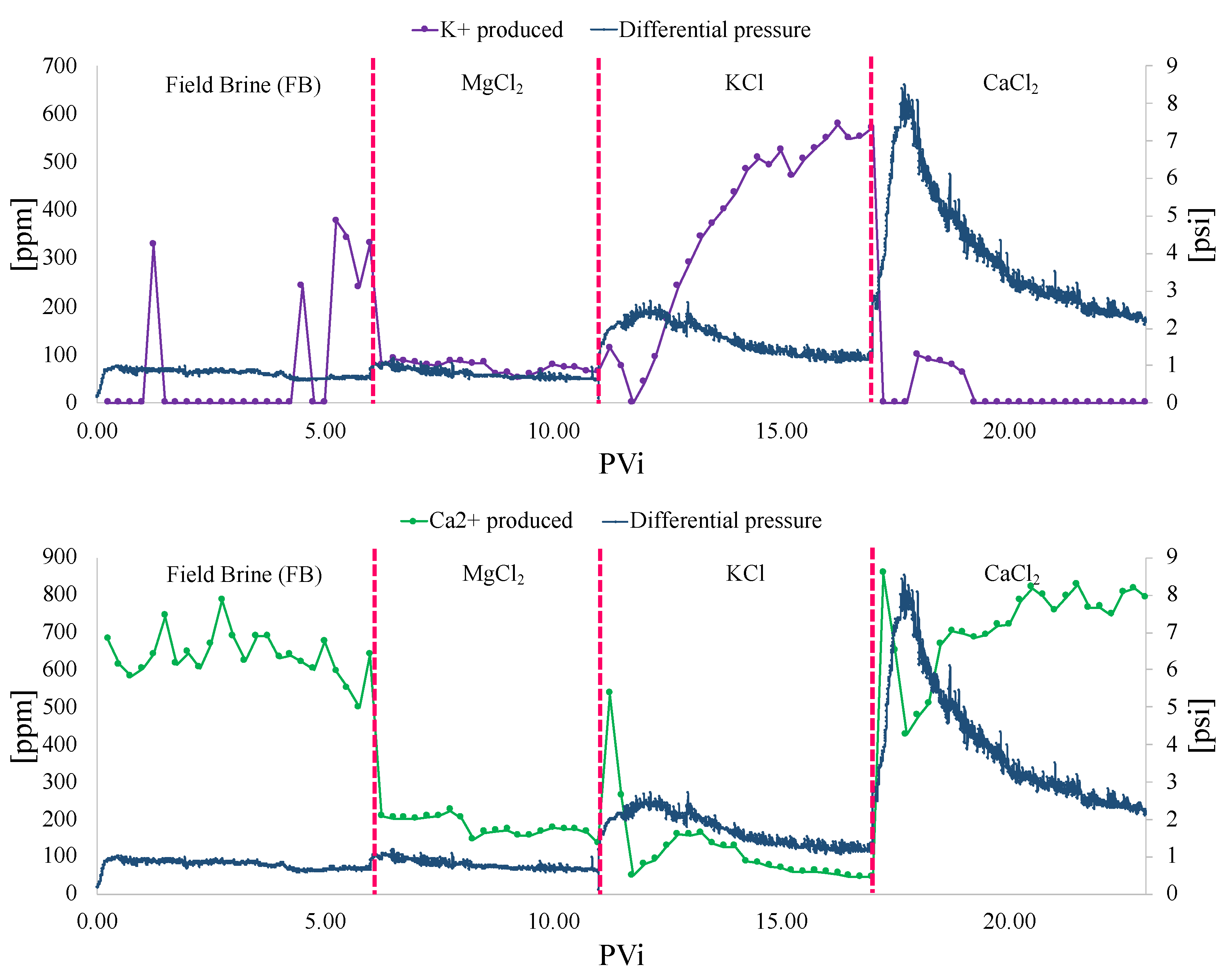
| Ion | Field Brine [mg/L] |
|---|---|
| Na+ | 3297.39 |
| K+ | 81.13 |
| Ca++ | 370.62 |
| Mg++ | 61.41 |
| Ba++ | 36.55 |
| Sr++ | 23.25 |
| HCO3− | 1521.15 |
| SO4− | 4.00 |
| Cl− | 5366.23 |
| TDS | 10,800.00 |
| Property | Unit | Value |
|---|---|---|
| Saturated compounds | (wt%) | 41.94 |
| Aromatic compounds | (wt%) | 30.85 |
| Resins | (wt%) | 22.72 |
| Asphaltene content | (wt%) | 4.49 |
| Acid number (AN) | (mg KOH/g oil) | 0.21 |
| Specific gravity | °API | 27.00 |
| Viscosity 60 °C | cp | 10.50 |
| Elemental Chemical Composition by EDXS | |
|---|---|
| Major Elements Detected | % |
| SiO2 | 90.1 |
| Al2O3 | 6.93 |
| K2O | 1.85 |
| Fe2O3 | 0.7 |
| TiO2 | 0.21 |
| CaO | 0.06 |
| Berea Slices—Contact Angle Determinations | |||||
|---|---|---|---|---|---|
| Length (cm) | Diameter (cm) | Pore Volume (cm3) | Porosity (%) | Klinkenberg Permeability (mD) | |
| 0.9–1.0 | 3.70 | 14.9 | 22.2 | 576 | |
| Berea plugs—Coreflooding Tests | |||||
| Water–Oil displacement | 6.75 | 3.84 | 16.7 | 21.6 | 557 |
| Water displacement | 6.94 | 3.84 | 17.2 | 21.6 | 547 |
| Brine | [ ] | IFT | SD | Brine | [ ] | IFT | SD |
|---|---|---|---|---|---|---|---|
| ppm | [mN/m] | ppm | [mN/m] | ||||
| NaCl | 1000 | 32.78 | 0.15 | MgCl2 | 1000 | 32.24 | 0.15 |
| 3000 | 32.39 | 0.14 | 3000 | 32.81 | 0.17 | ||
| 5000 | 32.64 | 0.13 | 5000 | 32.45 | 0.17 | ||
| KCl | 1000 | 32.53 | 0.18 | CaCl2 | 1000 | 32.56 | 0.16 |
| 3000 | 32.07 | 0.11 | 3000 | 32.54 | 0.17 | ||
| 5000 | 32.38 | 0.14 | 5000 | 32.25 | 0.13 | ||
| DW | – | 35.24 | 0.14 | FB | 10,800 | 30.06 | 0.14 |
| Parameter | Value |
|---|---|
| Confining pressure (psi) | 2000 |
| Pore pressure (psi) | 200 |
| Temperature (°C) | 60 |
| Brine rate (mL/min) Displacement efficiencies | 0.167 |
| Oil/brine resaturation rate (mL/min) | 0.1–0.2 |
| Brine viscosity at 60 °C [cP] | 0.48 |
| Crude oil viscosity at 60 °C [cP] | 10.5 |
| DE1 FB | DE2 MgCl2 1000 ppm | DE3 KCl 1000 ppm | DE4 CaCl2 2000 ppm | |
|---|---|---|---|---|
| Sw | 26.36% | 19.85% | 10.26% | 14.42% |
| Soi | 73.64% | 80.15% | 89.74% | 85.58% |
| %DE | 41.52% | 32.06% | 37.96% | 60.20% |
| Cl− | Na+ | K+ | Mg2+ | Ca2+ | ||
|---|---|---|---|---|---|---|
| ID | Brine | ppm | ppm | ppm | ppm | ppm |
| DE1 | FB | 6228.0 | 3166.0 | ND | 40.4 | 503.1 |
| DE2 | MgCl2 | 791.2 | - | - | 255.3 | - |
| DE3 | KCl | 567.8 | - | 524.3 | - | - |
| DE4 | CaCl2 | 1308.7 | - | - | - | 722.3 |
Disclaimer/Publisher’s Note: The statements, opinions and data contained in all publications are solely those of the individual author(s) and contributor(s) and not of MDPI and/or the editor(s). MDPI and/or the editor(s) disclaim responsibility for any injury to people or property resulting from any ideas, methods, instructions or products referred to in the content. |
© 2023 by the authors. Licensee MDPI, Basel, Switzerland. This article is an open access article distributed under the terms and conditions of the Creative Commons Attribution (CC BY) license (https://creativecommons.org/licenses/by/4.0/).
Share and Cite
Maya, G.; Carreño Otero, A.L.; Monares Bueno, F.L.; Romero Bohórquez, A.R.; Cortés, F.B.; Franco, C.A.; Manrique, E. Rock–Oil–Brine Dominant Mechanisms in Smart Water Flooding. Energies 2023, 16, 2043. https://doi.org/10.3390/en16042043
Maya G, Carreño Otero AL, Monares Bueno FL, Romero Bohórquez AR, Cortés FB, Franco CA, Manrique E. Rock–Oil–Brine Dominant Mechanisms in Smart Water Flooding. Energies. 2023; 16(4):2043. https://doi.org/10.3390/en16042043
Chicago/Turabian StyleMaya, Gustavo, Aurora L. Carreño Otero, Fabián L. Monares Bueno, Arnold R. Romero Bohórquez, Farid B. Cortés, Camilo A. Franco, and Eduardo Manrique. 2023. "Rock–Oil–Brine Dominant Mechanisms in Smart Water Flooding" Energies 16, no. 4: 2043. https://doi.org/10.3390/en16042043







